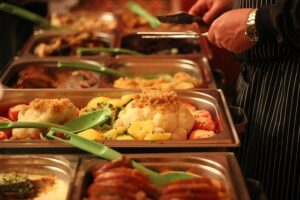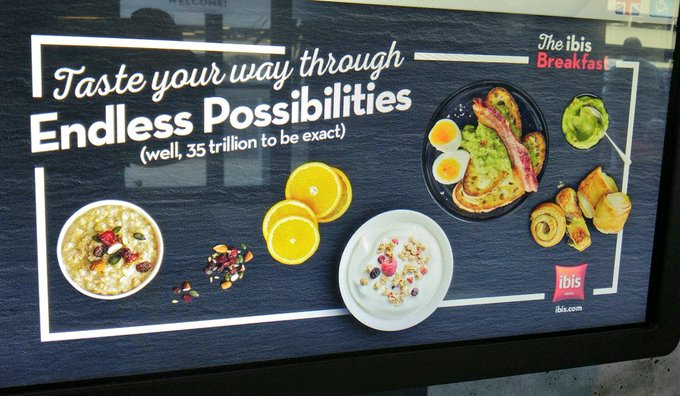Picking and choosing
Katie Steckles

In a post last April, I described some of the mathematics behind combinatorics – the branch of mathematics concerned with counting all the different ways to do something. Often, this kind of maths appears in daily life – if you’re trying to work out how many combinations of something are possible, or how many different orders something could occur in.
This question also seems to occur to marketing executives on a regular basis – when they realise that their product can be sold in many different combinations to the consumer. It seems very exciting to marketing teams, in a way that it’s not necessarily that exciting to anyone else, that the number of possible combinations might be very large.

The problem comes when marketing teams try to calculate the number of possibilities – and even though the maths involved is fairly straightforward, fail to check their answer is actually correct (presumably most companies employ at least one mathematician that they could run it by?) This happens surprisingly often, leading to wildly inaccurate or confusing claims.
A few years ago, I experienced this first hand – when I checked into a hotel, to find they had a sign explaining that their breakfast buffet offered ‘Endless possibilities (well, 35 trillion to be exact)’. My initial curiosity (‘Why would you claim something is endless when it’s finite?’ ‘Is the number exactly 35 trillion?’ ‘How would you calculate that?’) turned to fury when I realised that the answers were, respectively, ‘Because we don’t know how maths works’, ‘Probably not’ and ‘We’re not telling you’.

On a breakfast buffet, you could consider each item as something you either have, or don’t have, on your breakfast. This means the number of possible combinations would be two to the power of the number of things on your buffet – for each, you choose one of ‘yes’ or ‘no’. For the number to be in the region of 35 trillion, a suitable number of breakfast buffet options should be 45 – since 245 = 35,184,372,088,832. This is, regardless of your level of precision, not in any way exactly 35 trillion (it’s out by a little over 184 billion), but this could explain where that number has come from.
In the wake of this realisation, I looked carefully at the buffet to see if there were exactly 45 different foods to choose from, but things quickly became unclear (Do you count different flavours of jam as different options? And is two sausages a different item to one sausage?). I also surmised that since a sizeable proportion of the possible combinations would be objectively horrible (with several other suggestions for horrible combinations contributed by my Twitter followers), this impressive number of possibilities doesn’t necessarily mean an impressive number of enjoyable breakfast combinations.
Part of the problem with these kinds of adverts is that it’s not always clear what counts as a combination. Last year the team at The Aperiodical wrote about a promotional Superbowl advert run by the makers of Pringles, in which they introduce the concept of stacking three different flavours of Pringles together and eating them all in one go – clearly a delicious thing to do – and claimed excitedly that there were 318,000 possibilities.
Several people on Twitter tried to work out where this oddly specific number came from, and realised there are a lot of considerations. How many flavours are you choosing from? How many Pringles go in a stack – does it have to be three, like in the advert, or can it be another number? And does it matter what order the flavours go in? (Presumably, you get a stronger hit of whichever one touches your tongue first, so it would be a different experience if you put a BBQ one underneath a Sour Cream & Onion).
One person took the step of directly contacting Pringles about this, and their social media team stepped up. Their reply, which answered all these questions, was clearly informed by someone having done some actual maths. With 25 Pringles flavours, in a stack of two, three, or four, and counting all the different orderings, you do get a total of 318,000. You need to first calculate the number of ways to pick 2 things from 25 – which is 25 choices for the first thing, times 24 for the second – then add this to the number of ways to pick 3 things (25 × 24 × 23) and the number of ways to pick 4 things (25 × 24 × 23 × 22).
Strictly, the wording of their tweet, in which they say the calculation “assumes the same flavors are not stacked in a different order”, could imply that the ordering is not important (so we’d need to divide each term by the number of ways to reorder, two, three or four things respectively), but if you bear in mind the ambiguity of written English and the difficulty of communicating knotty maths concepts like this, I’m happy to give them the benefit of the doubt.
It turns out this kind of maths is difficult – not necessarily because of the numbers, but because you have to know exactly what question you’re answering. In 2002, McDonald’s launched the McChoice menu in the UK – offering eight different items and claiming 40,312 different possible combinations. It’s impressive, but also somewhat unclear where this number comes from (and Twitter wouldn’t exist for another four years, so you couldn’t ask their social media team).

With 8 items, each of which you can either have or not have, there are only 28 = 256 different combinations, which is not nearly as many as they claim. With a little thought, it becomes apparent that they’ve calculated the number of different orderings you can put 8 items of food in (8! = 40,320), but then conscientiously excluded the 8 meals consisting of exactly one item, subtracting 8 to give 40,312, which is patently nonsense.
If this makes you angry, you might be pleased to hear that 154 brave souls complained to the Advertising Standards Agency and McDonald’s were taken to court to fight the claim – which McDonalds won after an appeal, by claiming that’s not what they meant, changing their story and convincing the ASA that they just meant there were a lot of options (and if you include different flavours of milkshake and other variants, there are actually a lot more combinations than 40,312). But this mixing of methods did lead to at least one new mathematical discovery – the McCombination numbers (of the form N! – N), which have yet to find an actual practical use.
While it’s nice to see maths being used, these claims are often actually a bit meaningless. Even if you have exactly 45 items on your breakfast buffet, the number of breakfasts you can have won’t be 245 – since you could have more than one of some items, and eat them in a different order (which might make for a different meal) – so any attempt to calculate the actual total is futile. You certainly can’t claim ‘to be exact’!
Maybe it’s best to follow the lead of one of my favourite combination miscalculations in advertising – the Rubik’s cube. In the early days, it was advertised as having ‘Over 3 billion combinations’ – a very impressive number, but in truth slightly shy of the actual 43,252,003,274,489,856,000 (43 trillion) combinations possible on a 3x3x3 Rubik’s cube.
Before mathematicians worked out the maths behind the cube’s complicated twists and turns, the exact number might not have been known, even to the engineer Rubik who designed the cube. But even though 3 billion is a massive underestimate, in combination with the word ‘Over’, the statement is strictly mathematically accurate! That’s what I like to see.
Der Beitrag Picking and choosing erschien zuerst auf Heidelberg Laureate Forum.